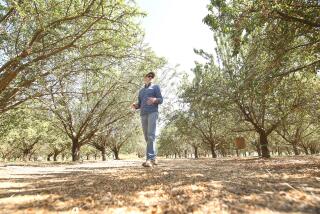It’s Humans vs. Insects in Food Fight--and Insects Appear to Be Winning : Farming: Alternatives to pesticides are sought in battle against crop-destroying pests. ‘Good’ bugs, enzymes and natural controls are among the possibilities.
- Share via
BELTSVILLE, Md. — We have met the enemy, and it has six legs.
In the Battle of Southern California, it was the tiny poinsettia white fly that devastated the region’s fall vegetable crops--the latest struggle in the long-running war between humans and insects over food.
The news from the front is not all good.
“I guess the insects are winning,” concedes Douglass R. Miller, head of research for the Systematic Entomology Laboratory at the U.S. Agriculture Department’s research center here.
As much as 95% of the fall melon crop in California’s Imperial Valley was lost last year to swarms of white flies so thick that they plastered windshields and lodged between farm workers’ teeth.
Other crops were savaged by the hungry creatures as well: citrus fruits, grapes, sugar beets, lettuce, cauliflower, broccoli, squash, cabbages and carrots.
With winter settled in and the insects retired from the field, scientists are using the cease-fire to figure out what to do next. Their first job has been to determine what they’re up against.
“We suspect the white fly was introduced into the United States from somewhere else, and has no effective natural enemies here,” Miller said. “There is also a remote possibility that it’s something that changed into a whole new biotype once it got here, though we doubt that in this case.”
A new biotype would be an insect that belonged to the same species (that is, it could mate with others and produce offspring) but would have different biological characteristics because of mutation or reorganization of genetic material.
These characteristics could be passed to successive generations, resulting in a new breed of insect that is impervious to existing insecticides or capable of overcoming natural resistances that have been built up in plants.
In the case of Southern California’s white fly, “we’re working very hard to try to find differences in appearance, and as yet we have not been able to find any,” Miller said. “But there are some major differences in some of the enzyme systems and in terms of behavior.”
Such clues are eagerly sought, as farmers and environmentalists alike increasingly demand less reliance on chemical pesticides such as DDT--banned in this country since 1971 for all but essential uses--to control bugs.
One promising approach to controlling insects such as the white fly is to find “good” bugs to wipe out “bad” ones.
“Most crop-damaging insects and weeds in the United States came from somewhere else, but left their natural enemies behind,” said Richard Soper, who heads the Agriculture Department’s research program on natural pest controls. “We want to turn the tables on the pests by bringing their worst adversaries to this country.”
In 1991, U.S. Agriculture Department scientists overseas shipped a record 402,766 pest-fighting insects and mites into the United States. The bugs are aimed at helping control more than two dozen insect pests, as well as weeds, another enemy of agriculture.
Bugs are not released wholesale into the U.S. environment without careful study to ensure that they don’t cause more harm than they were intended to alleviate.
Another method of attack is to help nature itself as it tries to keep marauding insects in check through plant evolution.
Over centuries of exposure in Europe, for example, rye has developed a genetic hostility toward a rye-loving insect known in this country as the Hessian fly.
The pest is believed to have been brought into the United States more than 200 years ago in the straw bedding of Hessian mercenaries hired by the British to fight in the Revolutionary War. George Washington routed the Hessians at Trenton, N.J., but their flies have plagued American wheat fields ever since.
Wheat varieties that genetically resist the feeding larvae have been used to fight the bug, says entomologist J. H. Hatchett, who heads an Agriculture Department research team in Manhattan, Kan. But some of those genes are losing their effectiveness because new strains of the fly can overcome the plant’s resistance.
Hatchett’s team is trying to assist the plant’s natural defenses by transferring fly-resisting genes from rye to wheat, with the help of X-rays.
“We feel there’s a possibility that, in the long run, rye genes may be more durable than those in wheat,” Hatchett says.
“My personal view is that we should be looking toward the natural controls rather than chemical controls,” said Douglass Miller. “But I do believe we’ll always be using chemicals of some sort, because there are going to be organisms that we don’t know enough about.”






